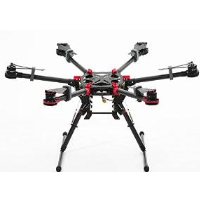Record Meth Seizures at the Border, but Drone “Mule” Is a First
 Spreading Wings 900 drone
Spreading Wings 900 drone
The “Breaking Bad” television show notwithstanding, 90% of the methamphetamine consumed in the United States comes from south of the border, not mobile meth labs driving around the New Mexico desert. Most of that traffic is across the California-Mexico border.
The U.S.Drug Enforcement Administration (DEA) reported that seizures of meth at the U.S.-Mexico border hit a record high in the fiscal year ending last September 30 and were up 33% around the San Diego area. But it wasn’t until this week that the drug trafficking passed a technological milestone.
Mexican police said a drone carrying pounds of meth crashed in a Tijuana shopping mall parking lot Tuesday night, just steps from the border. U-T San Diego said the Mexican police speculated that the drugs were being moved among Tijuana neighborhoods, and not across the border, but they couldn’t prove that.
Media reports were mixed on whether this was the first time a drone was known to have been used to mule drugs across the border or whether it was just the first time a capture was publicized.
The $1,400 Spreading Wings 900 drone (available on Amazon) was carrying three kilos (around 6.6 pounds) of meth, according to police, not a heavy haul. That prompted DEA spokesperson Amy Roderick to dismiss drones as a trafficking nonthreat.
“This method will only allow a small amount of drugs to be flown at a time,” she said. “That coupled with the ease of detection, does not make this method very profitable to these drug trafficking organizations whose motivation is money.”
Not everyone agrees. Perhaps the Spreading Wings 900, and its small payload potential, won’t revolutionize the drug biz, but a blogger at Drugs, Guns and Politics in Mexico says that is already changing:
“Working from US, European and Israeli designs, aeronautical engineers in Mexico and Latin America have been hard at work to find a drone that can be transported quickly by truck, launched and recovered and subsequently moved and has enough payload weight to meet the needs of their employers (Sinaloa Federation).”
David Shirk, an expert in Mexico security and justice issues at the University of San Diego, told U-T San Diego he concurred: “If it can be useful and productive, organized crime groups will find a way.”
They certainly have an incentive. U.S. Customs and Border Protection says 14,732 pounds of meth, 63% of all the highly addictive drug seized last year at U.S. entry points, were grabbed by its San Diego office. That’s nearly a 300% increase since 2009.
The numbers continue to go up since the U.S. cracked down on sales of the ingredients used to make the synthetic drug. Seizures of the drug have tripled in the past five years, as U.S. manufacturers lose their market dominance.
Although using drug busts as a measure of drug usage is fraught with peril, the DEA report does say there are indications that meth’s availability is up while demand is “less certain.”
–Ken Broder
To Learn More:
Drone Carrying Meth Falls Near Border (by Morgan Lee, U-T San Diego)
Drones Would Make the Perfect Drug Mules (by John L. Davidson, Quartz)
Meth Is Flooding California—and You Can Blame Mexican Cartels (by Meredith Hoffman, Vice News)
Drone Loaded with Meth Crashes Near Mexico-California Border (by Ryan Parker, Los Angeles Times)
Drone Carrying Meth Crashes Near San Ysidro Port of Entry (by Laura McVicker, NBC San Diego)
Drug Cannons and Drones (Drugs, Guns and Politics in Mexico)
Record Border Meth Seizures (by Sandra Dibble, U-T San Diego)
Indiana and Tennessee Lead Nation in Meth Labs (by Noel Brinkerhoff, AllGov)
Nationwide Methamphetamine Incidents Through August 2014 (pdf)
San Diego Sector Border Patrol Highlights Fiscal Year 2014 Accomplishments (U.S. Customs and Border Protection)
2014 National Drug Threat Assessment Summary (Drug Enforcement Administration) (pdf)
- Top Stories
- Controversies
- Where is the Money Going?
- California and the Nation
- Appointments and Resignations
- Unusual News
- Latest News
- California Forbids U.S. Immigration Agents from Pretending to be Police
- California Lawmakers Urged to Strip “Self-Dealing” Tax Board of Its Duties
- Big Oil’s Grip on California
- Santa Cruz Police See Homeland Security Betrayal in Use of Gang Roundup as Cover for Immigration Raid
- Oil Companies Face Deadline to Stop Polluting California Groundwater





